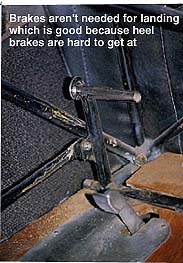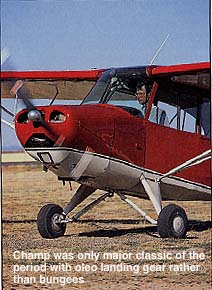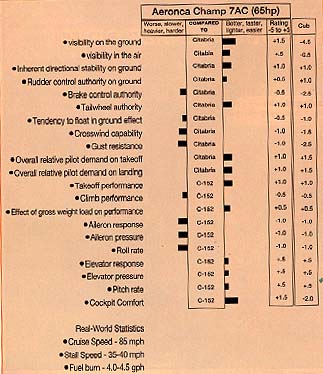Flight Characteristics
It takes about ten seconds in a Champ's cockpit to decide that
all of Chief Designer Hermes' Anti-Cub design goals were met and
then some. Some argue the Champ cockpit is too modern. Too civilized.
Those are usually Cub pilots speaking.
Once on board, the immediate impression will be of visibility
and a cheerful airiness. The wing and skylight is so high and
the pilot sits so far forward, there is none of the "Man
trapped in an airplane" feeling of so many of the Champ's
contemporaries. This is definitely the airplane for a big person.
 One of the cockpit's niceties is that all of
the major engine controls, i.e. carb heat, fuel on/off, mags are in a panel
by the pilot's left hip. This makes them available from both seats, although
the front seat pilot has to squirm around a bit to get a hand down there.
One of the cockpit's niceties is that all of
the major engine controls, i.e. carb heat, fuel on/off, mags are in a panel
by the pilot's left hip. This makes them available from both seats, although
the front seat pilot has to squirm around a bit to get a hand down there.
Incidentally, the later airplanes have most of the fuel in
the wings and do away with the fuselage tank, while the original
airplanes have a fuel gage peeking out of the top of the boot
cowl for the fuselage tank.
If it's a 7AC, you'll be doing the "Brakes! Contact!"
routine with an Armstrong starter. If a 7EC, there's a "T'
handled on the right half of the instrument panel that eases the
starting chores.
In most areas, there's a big handling difference between the
A and E models because of the difference in weight. An original,
lightly finished A model with its 65 hp Continental weights about
710-725 pounds or about the same as a Cub. The 90 hp E models
sometimes weigh as much as 200 pounds more because of electrical,
interior, tanks, etc.
There's some difference of opinion as to how to start a take-off
in a Champ, stick forward or stick back. A lot of the flight schools
that used later 7ECs with the No-Bounce gears routinely started
the takeoff roll with the stick full forward. Presumably, this
was done to get the tail up as soon as possible to keep the oleos
from extending. If the pilot waits too long to pick the tail up,
the weight will come off the oleos while in a three-point position
allowing them to extend. When they're extended, they have little
to no resistance so they'll compress easily. When one compresses,
even though the airplane is headed straight, the illusion is that
the airplane is turning and pilots often poke in rudder that's
not needed causing a swerve where there was none. Bear in mind,
however, that all of this is happening in slow motion as the airplane
will fly-off somewhere in the neighborhood of 45 mph.
Theoretically, the bigger engine Champs will climb better than
the lowly 7AC, but not by much. The books say an AC is supposed
to give 500 rpm and the EC 800 rpm. In real life, the difference
isn't that great. Because of its lighter weight, the 7AC floats
off the ground compared to the 7EC which feels more like it's
on rails. Only the very lightest 7AC, however, has the feather-like
feeling of a Cub when it separates.
Most of the Cub's resemblance to a feather is probably because
the Cub has just enough more wing area that its wing loading at
gross is a little lower, 6.8 lb/sq. ft to 7.1 lb/sq. ft. The books
say a 7EC weighs 890 pounds empty (1450 pounds gross, more than
a C-140) compared to a 7AC at 710 pounds (1220 pounds gross, about
the same as a Cub).
Note that the 7EC, despite its much bigger engine has about
the same useful load as the 7AC.
O nce up to cruising speed, the
7AC (65 hp) can generally be depended on to be 5-8 mph faster than the similarly
powered Cub, or a good solid 85-90 mph. The 7ECs seem to run about 90-95 mph.
nce up to cruising speed, the
7AC (65 hp) can generally be depended on to be 5-8 mph faster than the similarly
powered Cub, or a good solid 85-90 mph. The 7ECs seem to run about 90-95 mph.
Ask any who fly a Champ and they'll all say its a "...rudder
airplane...". That's because its adverse yaw is so pronounced,
you either coordinate with rudder or slip and slide around on
the seat. It's much more noticeable than in a Cub. This makes
it a superb trainer.
When you start trying to compare things like roll rate and
aileron pressures between airplanes like Cubs and Champs, you're
dealing more with perceptions than actual differences. For one
thing, the Cub control stick juts up higher, especially in the
front seat, and has an innately "bigger" feel to it.
The mechanical advantage means the stick moves further than a
Champ's in the same situation, but the response is probably close
to being the same. The pressures, also, are close, but it is very
difficult to say. The perception is that Cub controls are heavier,
when they really aren't.
There is, however, a difference to the overall "feel"
of the controls. Somehow, a Cub feels a little more precise and
a touch quicker. We're splitting some very slow-speed hairs at
this point, but that seems to be the general opinion.
Compared to a C-152, the roll performance will seem leisurely
at best. The pressures are slightly lighter than a Citabria and
the roll rate about the same.
The Champ stalls normally, with just a tiny bit of edge to
it. Release the stick and it's flying again. Kick a rudder hard
and it rotates into a surprisingly comfortable spin that stops
as soon as you release back pressure and punch a rudder. Just
letting go will bring it out almost as quickly as doing something
deliberate.
Depending on the model, a Champ is happy to approach at just about any speed,
but keeping it under 60 cuts down the float. Three-point landings happen almost
automatically once you get used to a nose that's not in the way. The sight picture
isn't that much different than landing a C-152 on its mains and holding the
nose off. Actually, you can probably see more out of the Champ.
In a no-wind situation, the airplane will track perfectly straight.
Given a good cross wind, the pilot will have to work a little
harder but the airplane will handle it as long as the pilot keeps
the wing down and the nose straight.
Wheel landings are also automatic and probably easier than
in any other type of taildragger. Just don't force it on. Let
it find the ground, pin it in place and the landing is over.
The controversy between those who love the Cub and those who swear by the Champ
will never be resolved. The important thing to remember is they are both terrific
airplanes and the Champ wouldn't have survived as long as it has if it hadn't
had the Cub as a role model.

For lots more pilot
reports like this one go to PILOT
REPORTS.
 One of the cockpit's niceties is that all of
the major engine controls, i.e. carb heat, fuel on/off, mags are in a panel
by the pilot's left hip. This makes them available from both seats, although
the front seat pilot has to squirm around a bit to get a hand down there.
One of the cockpit's niceties is that all of
the major engine controls, i.e. carb heat, fuel on/off, mags are in a panel
by the pilot's left hip. This makes them available from both seats, although
the front seat pilot has to squirm around a bit to get a hand down there.  nce up to cruising speed, the
7AC (65 hp) can generally be depended on to be 5-8 mph faster than the similarly
powered Cub, or a good solid 85-90 mph. The 7ECs seem to run about 90-95 mph.
nce up to cruising speed, the
7AC (65 hp) can generally be depended on to be 5-8 mph faster than the similarly
powered Cub, or a good solid 85-90 mph. The 7ECs seem to run about 90-95 mph.
